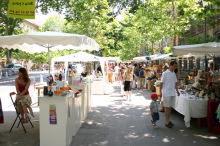The STAR project finished on 31st July 2015 - page no longer being updated
 | The STAR project final dissemination event was held in beautiful Aix-en-Provence, 9-11 June 2015The event presented the results of the 4.5 year research programme and discussed with the wider community the continued integration of radioecology with other radiation protection disciplines. The programme was a mixture of presentations, discussions, debates, posters, interactive demonstrations and social events. The program can be consulted |
Presentations | Presenter |
|---|---|
| The SRA in Radioecology: the seed for integration | J. Garnier-Laplace (IRSN) |
| Alliance - including COMET | F. Hardeman |
| Are radiation protection benchmarks for wildlife protective enough in a multiple stressor context? | R. Gilbin (IRSN) |
| Challenges and solutions identified by STAR | A. Real (CIEMAT) |
| Closing: Summary of the main conclusions from the debate sessions | L. Février (IRSN) |
| J.C. Mora (CIEMAT) | |
| Debate session - the radiation protection benchmarks for wildlife in a multiple stressor context | |
| Debate session - the robustness of ecological radioprotection criteria | |
| Debate session with the whole audience | |
| Debate session – integration of assessment methodologies | |
| Debate session – Pursuing sustainability and integration | |
| Enhancing Education and Training | L. Skipperud (NMBU) |
| EURADOS | J. Tschiersch |
| Exploring radiation effects at different biological scales (How do alpha and gamma radiation compare?) | N. Horemans (SCK•CEN) |
| Fukushima-derived radionuclides in marine biota | J. Nishikawa (Tokai Univ.) |
| How can we integrate the human and environmental radioprotection framework | C. Bradshaw (SU) |
| How wrong are you if you do not consider mixtures? | H. Vandenhove (SCK•CEN) |
| Increasing ecological relevance in radiological protection criteria | D. Oughton (NMBU) |
| Integrating radiation effects from molecules to populations | F. Alonzo (IRSN) |
| Introduction | F. Alonzo (IRSN) |
| Introduction - the ALLIANCE and the SRA | F. Hardeman |
| Making the most of what we have | N.A. Beresford (CEH) |
| MELODI | J.R. Jourdain |
| NERIS | T. Schneider |
| New research into marine radioecology off the Fukushima coastline | N. Fisher (SUNY) |
| Observatory sites – lessons learnt by STAR | M. Steiner (BfS) |
| A. Liland (NRPA) | |
| C. Svendsen (CEH) | |
| P. Vesterbacka (STUK) | |
| Sharing tools - Radioecology Exchange website | C. Barnett (CEH) |
| STAR objectives regarding integration | T. Ikäheimonen (STUK) |
| The CONCERT project | T. Jung |
Thursday 11th June The STAR toolbox: advancing radiation risk assessment and sharing knowledge | |
Tuesday 9th June The integration of radioecology at the European level | |
| Understanding bioaccumulation is required for explaining/predicting mixture effects | H.-C. Teien (NMBU) |
| Understanding bioavailability is important to understand mixture toxicity | S. Lofts (CEH) |
| Understanding underlying mechanisms is required for explaining/predicting mixture effects | C. Bradshaw (SU) |
Wednesday 10th June Protection frameworks for wildlife – advancing the underlying science through integrated research (Sorry, some of the presentations below have not been linked as much of the data presented has not yet been published; once it has been published the papers will be made available from the information exchange tab). | |
| Welcome address, a brief overview of STAR’s goals | J.C. Gariel (IRSN) |
(Picture credit: By Hogne (Own work) [CC BY-SA 1.0 (http://creativecommons.org/licenses/by-sa/1.0)], via Wikimedia Commons)
